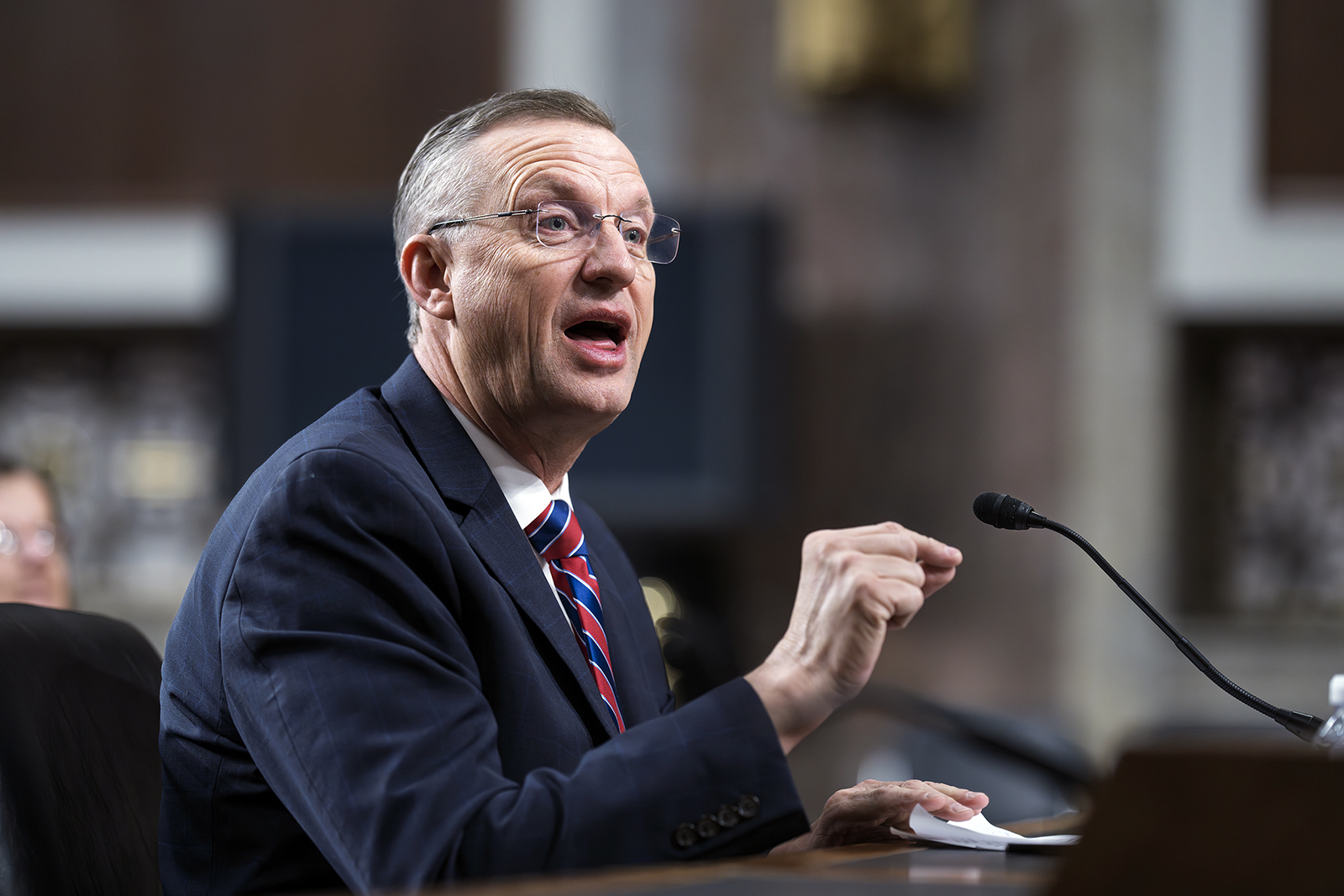(RNS) — Drawing on Latin American theology that emphasizes collaboration, developed in response to continued struggles with colonialism, Francis pushed for a Catholic Church with broader inclusion of people on the margins.
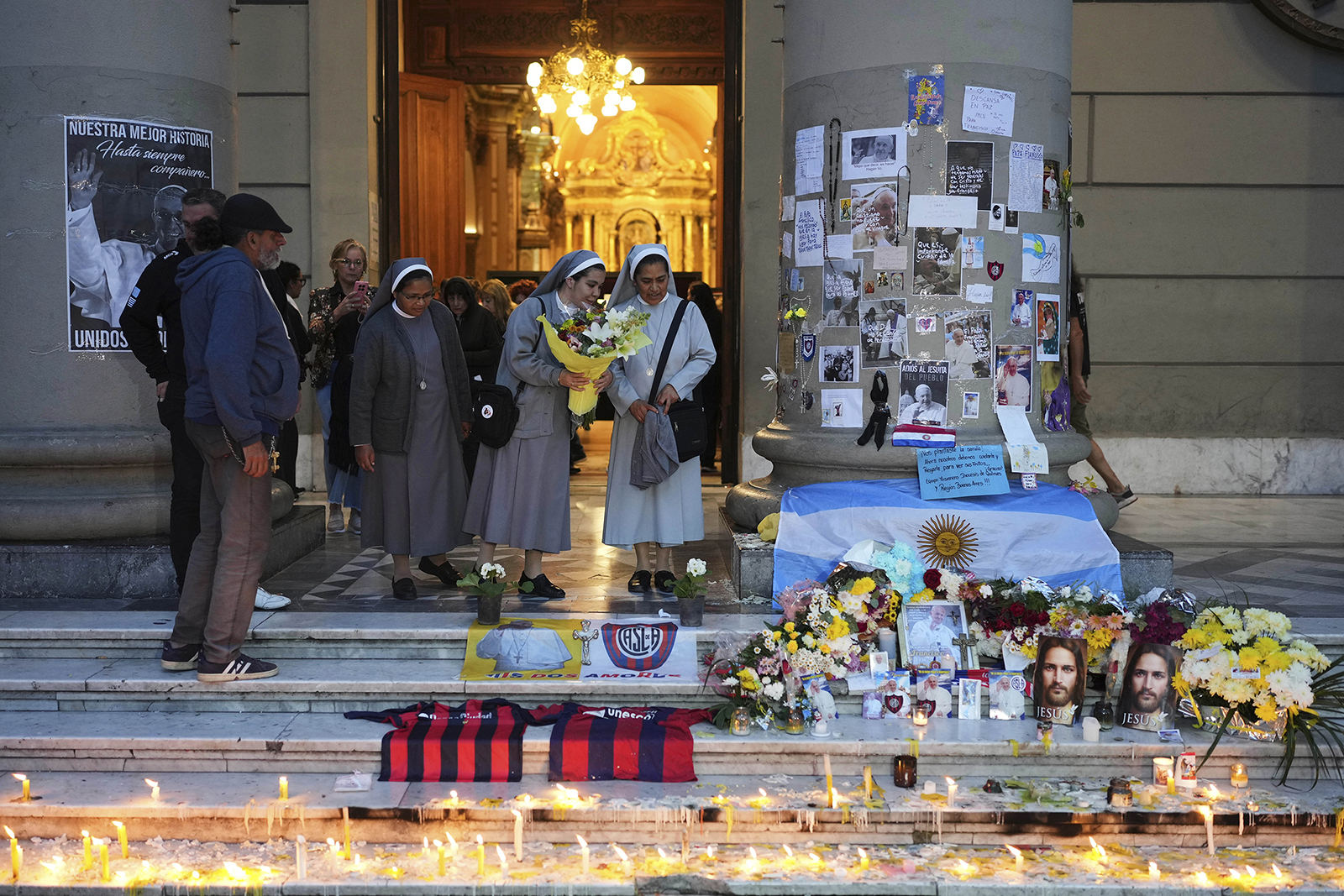
Nuns hold flowers and look at a memorial to the late Pope Francis outside the Metropolitan Cathedral in Buenos Aires, Argentina, Tuesday, April 22, 2025. (AP Photo/Rodrigo Abd)
Aleja Hertzler-McCain
April 22, 2025
(RNS) — When Pope Francis stepped onto the balcony of St. Peter’s Basilica for the first time back in 2013, he told the crowds below him that the College of Cardinals had gone “almost to the ends of the earth” to find the new bishop of Rome.
Over 500 years after papal bulls authorized the violent, colonial conquest of non-Christian peoples, paving the way for Catholicism to take root in the Americas, Francis was the first pope to emerge from those lands. Drawing on the region’s theology that emphasizes collaboration and developed in response to continued struggles with colonialism, Francis pushed for a Catholic Church with broader participation and inclusion of people on the margins, scholars told RNS before and after his death on Monday (April 21).
“We were, for several centuries, a church that reflected what they do in Europe — we repeated, copied Europe,” said Maria Clara Lucchetti Bingemer, a theology professor at the Pontifical Catholic University of Rio de Janeiro, in Spanish.
Latin American bishops began to implement the teachings of the modernizing Second Vatican Council right after the council in the early 1960s. And as a result, “we try to be a church that is a source, a church that generates its own content, that generates the way we celebrate our rituals, that generates our priorities,” Bingemer said. Francis made sure those efforts grew “in a strong and exponential way.”
As archbishop of Argentina, Cardinal Jorge Bergoglio, who would take the name Francis when he became pope in 2013, came up within the Latin American bishops’ conference, known as CELAM. That school of thought would become prominent during his papacy.
In 2007, he chaired the committee that drafted the final document for CELAM’s general conference in Aparecida, Brazil, which encouraged Catholics to be “missionary disciples” and described the church as the “home of the poor.” Both became key concepts six years later in Francis’ first apostolic exhortation, “Evangelii Gaudium,” in which the new pope encouraged the church to “go forth,” share “the joy of the Gospel” and understand “God’s heart has a special place for the poor.”
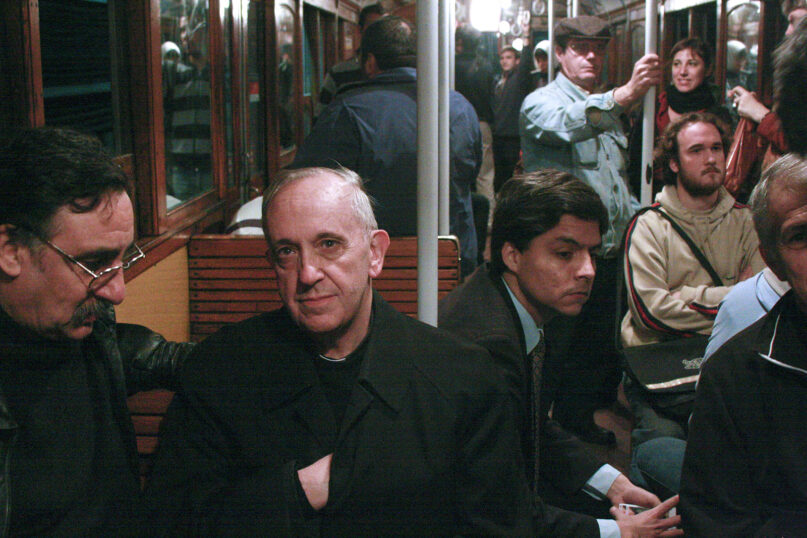
FILE – Cardinal Jorge Mario Bergoglio, second from left, travels on the subway in Buenos Aires, Argentina, in 2008. (AP Photo/Pablo Leguizamon, File)
Once Francis directed his theology to the world, Bingemer, who previously witnessed his firm leadership in Aparecida, said one could still “feel the presence of Latin American theology, the Latin American reception of the Second Vatican Council.”
While Francis might have shied away from labeling his influences as “liberation theology” — which Pope Benedict XVI once accused of uncritically borrowing Marxist influences — Bingemer said Francis’ theological lineage was clearly linked back to it, placing a heavy emphasis on the “preferential option for the poor.”
Reflecting the impact of migration experiences on Latin America, Francis emphasized the dignity of migrants throughout his papacy. He visited the island of Lampedusa in the Mediterranean Sea, a point of arrival for refugees and asylum-seekers, as his first trip outside of Rome. The new pope also celebrated Mass on an altar made of a painted boat, and he mourned “globalized indifference” and the migrants neglected by the world.
The Rev. Gustavo Morello, an Argentine Jesuit sociology professor at Boston College, said Francis’ papal policy was clearly marked by Argentine politics.
“ A key to understand Francis’ policy has been not progressive/conservative, not that distinction, but the distinction between peoples against elites,” a common tension within various ideological camps in Argentina, Morello said.
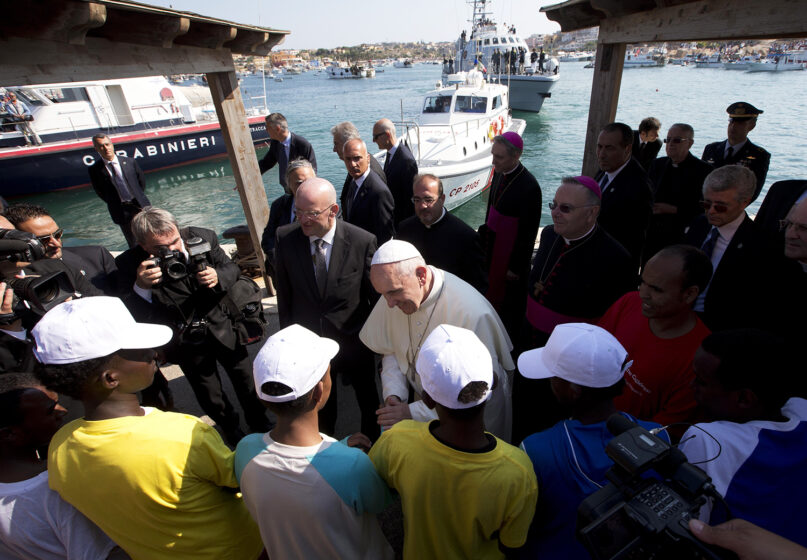
Pope Francis speaks to migrants, wearing white caps, during his visit to the island of Lampedusa, southern Italy, July 8, 2013. (AP Photo/Alessandra Tarantino, File)
Francis, known for his pastoral emphasis, focused on the people in front of him, Morello said, sometimes changing his mind when he saw people react against his decisions.
For example, after facing backlash when he dismissed accusations that Chilean leaders participated in covering up sexual abuse, Francis invited Chilean abuse survivors to the Vatican to ask for their forgiveness and to listen to them
RELATED: 135 cardinals will elect the next pope. Francis picked 108 of them.
As CELAM is also known for its open-ended discussions and collaborations, Latin American church leaders immediately recognized their theological tradition on display when Francis announced a new synod format in 2021 that would begin with widespread consultation of the faithful and conclude with assemblies that included laypeople and women alongside bishops. The listening and accompaniment in the process were termed “synodality” and became a key concept in the modern church.
“The notion of synodality is really taken to heart as listening first and putting aside one’s own agenda,” said Neomi De Anda, executive director of the International Marian Research Institute at the University of Dayton in Ohio. “Really listening to one another is a notion of decolonization because that decenters everyone and centers the act and the possibility of listening.”
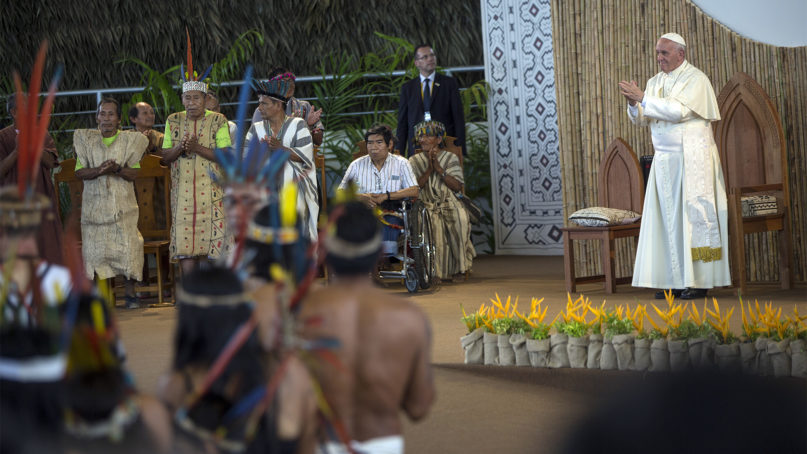
Pope Francis meets with Indigenous representatives in Puerto Maldonado, Peru, on Jan. 19, 2018. Standing with thousands of Indigenous Peruvians, Francis declared the Amazon the “heart of the church” and called for a three-fold defense of its life, land and cultures. (AP Photo/Rodrigo Abd)
De Anda, who has published research on decolonization, said that despite Francis’ efforts to apologize to Indigenous people for the church’s harm, “there’s still work to be done.”
“ There are big questions when it comes to decolonization and Christianity in general — about a religion that came from a colonizing perspective,” De Anda said. “And so, ‘how far can that be taken?’ I think is a fundamental question.”
Francis spoke forcefully against continuing colonialism, including about its impact on the environment and global conflicts.
Sister Ana María Siufi, a Sister of Mercy of the Americas, said Francis continuously denounced new colonization. He specifically focused on regions, including in Asia, Africa and Latin America, that had been heavily colonized and victims of “plundering, exploitation and domination by external debt,” she said in Spanish.
The pope’s environmental justice focus influenced Siufi in her own ministry in rural Argentine Patagonia that includes peasant and Indigenous Mapuche families. “Laudato Si’,” his environmental encyclical, “will continue to be one of the most extraordinary documents in the social and environmental doctrine” of the church, she said.
And for many Latin Americans and U.S. Latinos, Francis’ papacy allowed them to see their own faith traditions and culture take the highest stage in the church. His deep devotion to Mary, even asking to break tradition to be buried in the Basilica of St. Mary Major, and his fandom for his hometown soccer club remained familiar signs of where he came from.

Pope Francis approaches priests with an Argentine flag as he arrives in Saint Peter’s Square for his inaugural Mass at the Vatican on March 19, 2013. (Photo by Stefano Rellandini/Reuters)
But while he gained many fans and some prominent enemies becoming “the most relevant Argentinian figure in the 21st century,” Morello said inertia prevented Francis from recruiting more practicing Catholics in Latin America, where large majorities support at least some changes in the church’s teachings on gender and sexuality that Francis declined to back.
RELATED: Poll: Catholic support for women’s ordination rises in Latin America
Francis’ 2013 election was a nod to the fact that in 2010, Pew Research Center found that 39% of Catholics worldwide came from Latin America and the Caribbean, far outstripping the 24% of Catholics from Europe — the home continent of the most previous popes — representing a century-long shift of the church toward the Global South.
And shortly before his death, Vatican statistics confirmed that a majority of the world’s Catholics are now in Latin America and Africa, with 41% of global Catholics in Central and South America. The share of global Catholics in Africa rose to 20% in 2025, from 16% in 2010.
Africans have also been impacted by the Francis papacy, said the Rev. Agbonkhianmeghe Orobator, who is from Nigeria and is dean of the Jesuit School of Theology of Santa Clara University in Berkeley, California, recalling the tremendous excitement in Kenya when Francis was elected.
“I saw Pope Francis’ Jesuit identity in the attention he paid to vulnerable people at the margins and the peripheries of the church and of society,” said Orobator, a delegate for Francis’ Synod on Synodality.
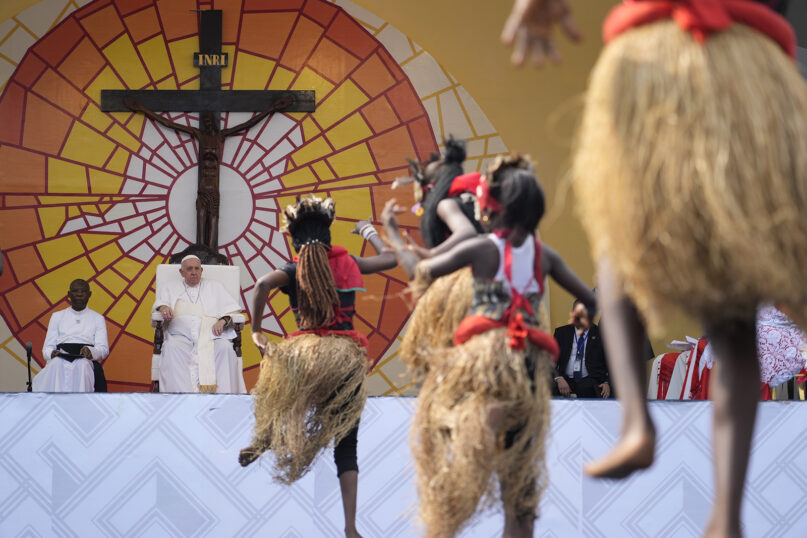
Pope Francis, second from left, watches traditional dancers perform at the Martyrs’ Stadium in Kinshasa, Democratic Republic of the Congo, Thursday, Feb. 2, 2023. Francis was in Congo and South Sudan for a six-day trip, hoping to bring comfort and encouragement to two countries that have been riven by poverty, conflicts and what he called a “colonialist mentality” that has exploited Africa for centuries.
Catholics of all ideological backgrounds are now beginning to anticipate who might take the papacy next. Siufi said, “I think we all have fear — fear that this will cut short a process that we consider very healthy, this process of reform that must continue.”
The College of Cardinals determining the next pope now more closely reflects the global Catholic Church than the 2013 conclave. Today, 13% of cardinal-electors are from South America, 13% from Africa and 17% from Asia; less than half of cardinal-electors will be from Europe.
But regardless of what part of the global church he represents, the next pope should carry forward Francis’ humanity, Orobator said. Whether working to support the South Sudan peace process or arriving a half-hour early to synod sessions to bless, take selfies with and talk to delegates, “what stood out to me is his humanity, and his ability to connect with people in their situation, be it of joy or of pain,” Orobator said of Francis. “He focused on people.
“The Holy Spirit will inspire the cardinals during the conclave to elect a pope that the church and world need at this time,” he said.
VATICAN CITY (RNS) — Francis leaves behind him a church still divided, but radically transformed.
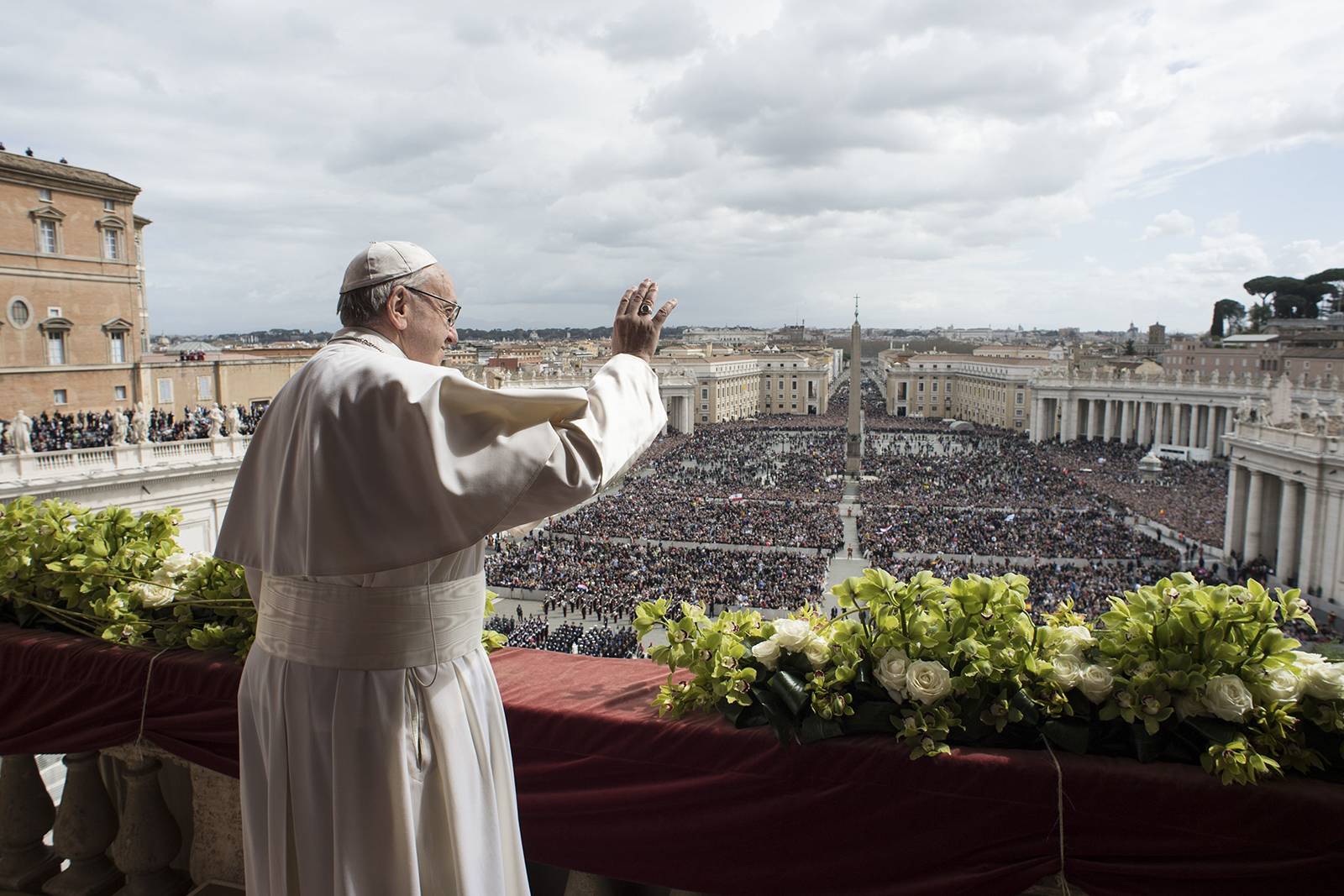
Pope Francis delivers the Urbi et Orbi (“to the city and to the world”) blessing at the end of the Easter Sunday Mass in St. Peter’s Square at the Vatican, April 1, 2018. (Vatican Media via AP)
Claire Giangravé
April 21, 2025
RNS
VATICAN CITY (RNS) — Pope Francis, who sought to be a bridge maker as he led the Catholic Church in a time of deep polarization, died at 7:35 a.m. on Monday (April 21), at the age of 88, a day after surprising faithful in St. Peter’s Square on Easter Sunday.
“He taught us to live the values of the Gospel with fidelity, courage and universal love, especially toward the poorest and most marginalized,” read a Vatican statement by Cardinal Kevin Farrell, who is charged with overseeing the papal funeral and the election of the next pope.
Francis died of a cerebral stroke that put him into a coma and led to heart failure at the Vatican’s Casa Santa Marta, according to the Vatican. Dr. Andrea Arcangeli, the head of the Vatican’s health department, said in a statement Monday that the pope also experienced episodes of respiratory insufficiency, and had Type 2 diabetes and hypertension.
The pope had been recovering from double pneumonia, for which he was hospitalized in mid-February and released after five weeks. Part of Francis’ lung had been removed at age 21 after a life-threatening pneumonia. As he aged, he suffered a number of ailments, from sciatica to cataracts to chronic knee pain, and visitors to the Vatican were accustomed to seeing the pope struggle to walk when not seated in a wheelchair.
With his pastoral style of leadership and his emphasis on mercy, however, Francis restored the credibility of the church in the eyes of Catholics and non-Catholics after decades of bad news about clergy sex abuse, financial scandals and decline in attendance at Catholic churches.
“The pontificate of Pope Francis has been a breath of fresh air for the Catholic Church globally. He was loved for his simplicity, humility, and warmth,” said Sandie Cornish, senior lecturer in theology at the Australian Catholic University and a member of the Vatican Dicastery for Integral Human Development.
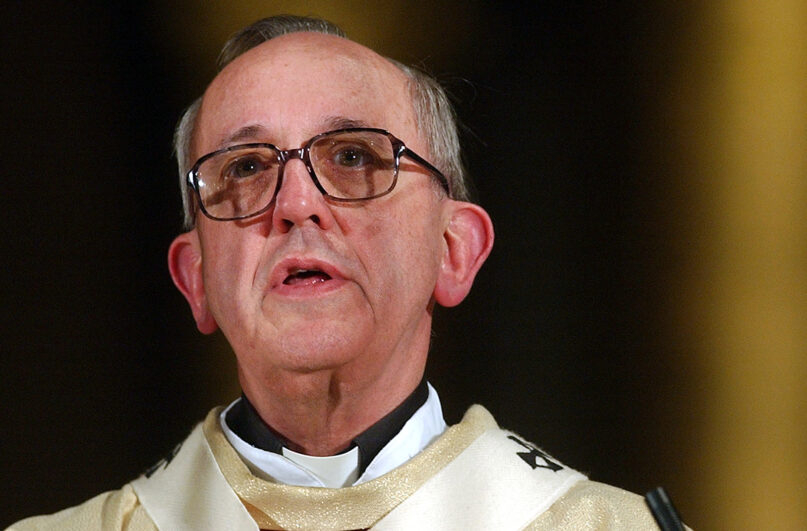
Argentine Cardinal Jorge Mario Bergoglio celebrates a Mass in honor of Pope John Paul II at the Buenos Aires Cathedral in Buenos Aires, Argentina, April 4, 2005. Bergoglio, who took the name of Pope Francis, was elected on March 13, 2013, as the 266th pontiff of the Roman Catholic Church. (AP Photo/Natacha Pisarenko, file)
“The first Jesuit Pope, the first Latin American Pope, the first Pope from outside Europe since the early church, Francis brought a fresh perspective ‘from below’ or ‘from the ends of the earth’ as he put it when he was elected,” Cornish added.
Francis was known for his commitment to welcoming migrants and refugees, the protection of the environment and support for the poor and marginalized, but he remained a polarizing figure for Catholics who mirror society’s political and ideological divisions. He was elected by his fellow cardinals in 2013 as a reformer who would restore credibility to the church’s troubled finances, restructure the Vatican’s Curial departments and the spiritual reform of the church’s leadership and faithful.
RELATED: Here’s what happens after a pope dies
Pope Francis succeeded Pope Benedict XVI as leader of the Catholic Church in 2013, after his predecessor shocked the Catholic world by stepping down as pontiff and took the title of emeritus pope. While Benedict remained silent, he was still regarded as a champion of conservative views in contrast to Francis’ softer approach to Catholic doctrine. His presence weighed on Francis’ tenure, despite joint efforts to present a united papacy, until Benedict’s death in 2022.
Born Jorge Mario Bergoglio to a family of Italian immigrants in Bueno Aires, Argentina, on Dec. 17, 1936, Francis spent his youth as a chemical technician and took occasional jobs as a bouncer and janitor. At 22 he began to follow a vocation to become a priest, and after two years as a novitiate he entered the Society of Jesus, the order known as the Jesuits, on March 12, 1960.
Ordained a priest in 1969, he became the provincial superior of the Jesuit order in Argentina in 1973, at a critical time known as the Dirty War, when the country’s military dictatorship relentlessly pursued and imprisoned its critics. Bergoglio was often criticized for not standing up to the regime. His relationship with the global Jesuit order was also strained due to his iron-fist leadership and opposition to liberation theology, which was becoming increasingly popular in Latin America.
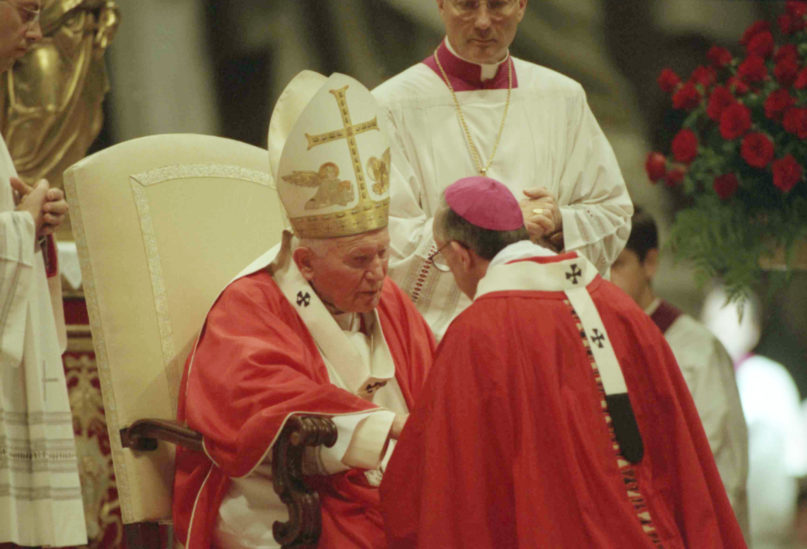
Pope John Paul II greets the archbishop of Buenos Aires, Argentina, Archbishop Jorge Mario Bergoglio, at the Vatican on June 29, 1998. (AP Photo/Sambucetti)
He became the archbishop of Buenos Aires in 1998, quickly earning the title of “slum bishop” for his ministry in the city’s poverty-stricken favelas. In 2001, Pope John Paul II made Bergoglio a cardinal and appointed him to a number of Vatican Curial positions. He had an influential role in creating the Aparecida document, a 2007 statement by Latin America’s Catholic bishops emphasizing the importance of the family, the environment and evangelization.
At the conclave after John Paul’s death in 2005, Bergoglio was one of the cardinals spoken of as “papabile,” or a credible candidate for the papacy, but the cardinals chose the continuity of Benedict, who as Joseph Ratzinger had been John Paul’s fierce doctrinal chief, sometimes called “God’s Rottweiler.”
When, in 2013, the cardinals did make Bergoglio St. Peter’s 265th successor, he took the name “Francis” in honor of St. Francis of Assisi, known for his devotion to the poor and the environment. The unassuming “Buonasera” (good evening) that he uttered to the waiting faithful in St. Peter’s Square after his election foreshadowed his humble approach to the papacy. Eschewing the grander Apostolic Palace, Francis chose to live in the hotel-like room of Domus Sanctae Marthae and eat with other Curial members. He opted for simple clothing and jewelry, distancing himself from the pomp and regalia of his predecessors.
He immediately set about making much-needed structural and economic reforms, continuing the work started by Benedict in the Institute for Religious Works, known as the Vatican bank, but more sensationally allowing 10 individuals, including Cardinal Angelo Becciu, to be tried for suspected fraud, embezzlement and money laundering. Francis stripped the powerful Secretariat of State of its investment assets and injected transparency into the Vatican’s acquisitions process. His Apostolic Constitution, Paredicate Evangelium (Preach the Gospel), merged many Vatican departments, eliminated redundancies and promoted more involvement of lay Catholics.
Francis’ sometimes tough reforms won him determined opponents inside the Vatican, but he bolstered his position by selecting some 80% of the cardinals heading 10 consistories. He gave red hats to prelates from a wide range of countries, including some that never had a cardinal before, creating the most diverse College of Cardinals in the history of the church.
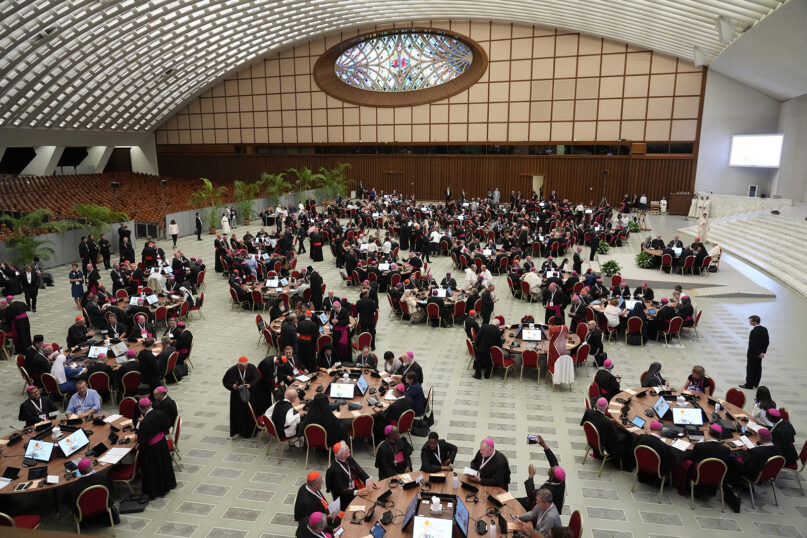
Pope Francis, sitting at right, participates in the opening session of the 16th General Assembly of the Synod of Bishops in the Paul VI Hall at the Vatican, Oct. 4, 2023. (AP Photo/Gregorio Borgia)
The pope sought to eliminate clericalism — the preferential treatment assumed by priests in the church that is as often awarded by lay Catholics. “The pope’s actions had the purpose of purifying the church to a great effect,” said Massimo Borghesi, a philosophy professor at the University of Perugia and author of “The Mind of Pope Francis: Jorge Mario Bergoglio’s Intellectual Journey.”
Francis’ efforts “led to the great oppositions and contrasts that he faced within the church,” Borghesi added.
To reconcile these tensions, Francis took a keen interest in calling summits of bishops, known as synods, to address key challenges facing the church, and stirring new conversations and discussions about female ordination and a married priesthood, inevitably drawing vocal opposition. The three-year Synod on Synodality, ending in October 2024, aimed to take the pulse of Catholics all over the world and to expand the people and views that go into the church’s decision-making.
Yet Francis made few changes to Catholic teaching itself. He enshrined the church’s opposition to the death penalty within the catechism and opened the door for divorced and remarried Catholics to receive the Eucharist with the spiritual guidance of a priest. He took a stronger stance against nuclear weapons and restricted the definition of just war that had been used by politicians to justify foreign interventions.
But when it came to questions of homosexuality, the female priesthood, abortion or euthanasia, “Bergoglio didn’t change a thing,” Borghesi said. “Conservatives thought he was a progressive pope, but from a traditional and dogmatic view, he was a conservative,” the professor said. Francis spoke candidly in opposition to abortion and criticized gender theories as a form of “ideological colonization.”
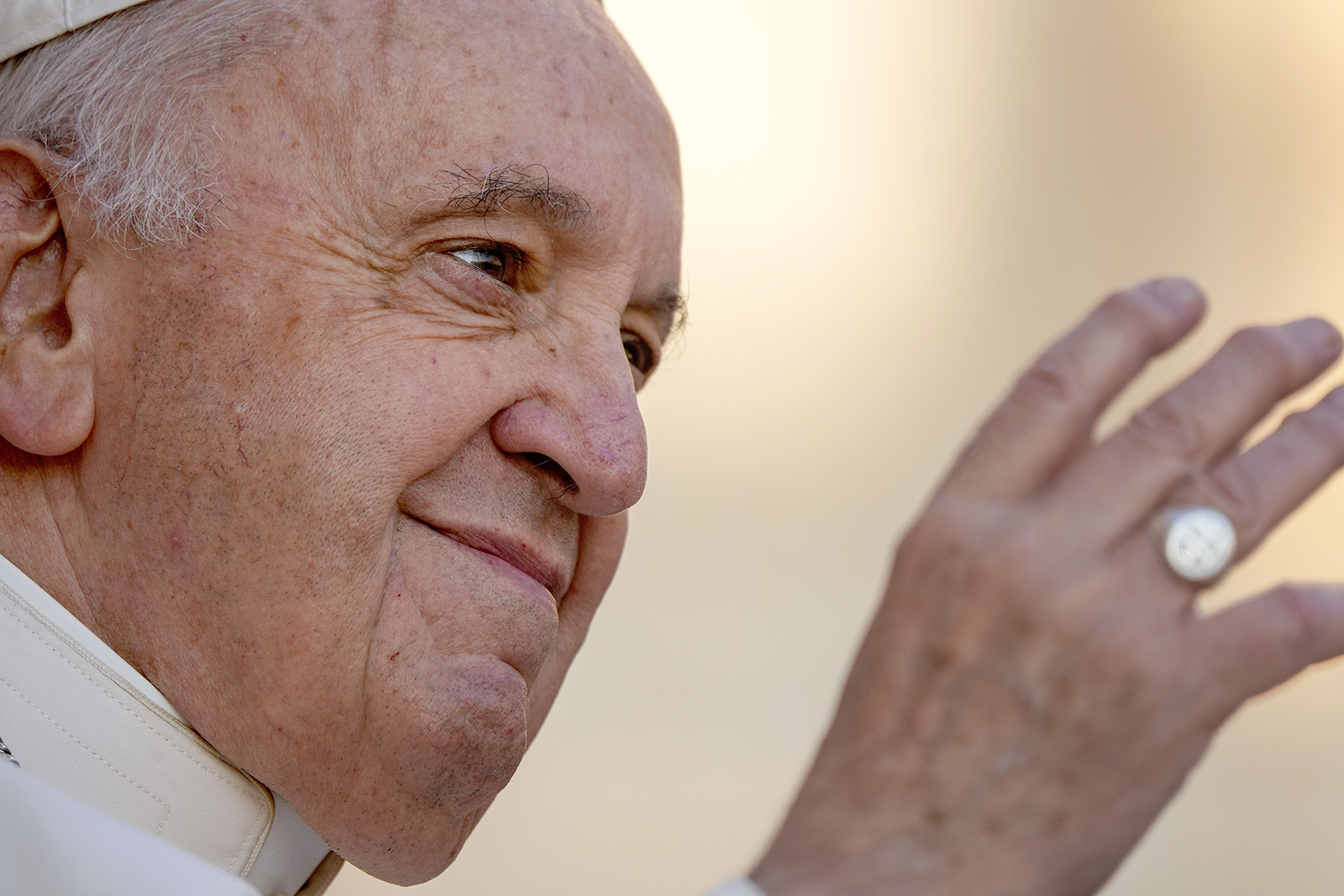
Pope Francis
Instead, Francis took a pastoral approach, setting aside theology in favor of personal encounters with gay couples and their advocates in the church. He invited trans sex workers to Vatican events and encouraged the appointment of women to lead Vatican departments.
“It will be difficult to return to a harsh and severe pope who only insists on rules and doesn’t walk the path of mercy, which Pope John Paul II and Pope Benedict XVI had already laid out, and is the way of the church in modern times,” Borghesi said. “I think there is no turning back from this.”
Francis took the reins of the Catholic Church at an all-time low in its popularity after years of bad news about bishops’ mishandling of clergy sexual abuse, capped by The Boston Globe’s 2002 “Spotlight” investigation showing countless cases of sexual abuse by clergy in the United States. The pope took on the abuse crisis by creating new laws obligating clergy to report abuse to the authorities, removed the pontifical secret from abuse cases and applied accountability measures in dioceses. At the Vatican, he created the Pontifical Commission for the Protection of Minors with the goal of advising the church on how to prevent abuse cases in the future.
Francis’ efforts had mixed results. The Vatican commission was stymied by political wrangling and the pope himself seemed to lower his disciplinary standards for those close to him, such as Bishop Gustavo Zanchetta, who was found guilty of pedophilia by an Argentine court, and Bishop Juan Barros, who covered up for the infamous Chilean pedophile priest Fernando Karadima.
Francis also enacted restrictions on the Traditional Latin Mass with his 2021 decree “Traditionis Custodes,” which was perceived as an attack on the most conservative factions in the church and in opposition with Benedict XVI’s opening toward the old rite.
Despite Francis’ failures, he did much to restore the church’s credibility in the world. “He was a pope who opened doors, leaving behind a church that speaks to all without fear,” Borghesi said. “This pope made the church acceptable and admirable once again after the grave scandals that marked the time that preceded his pontificate.”
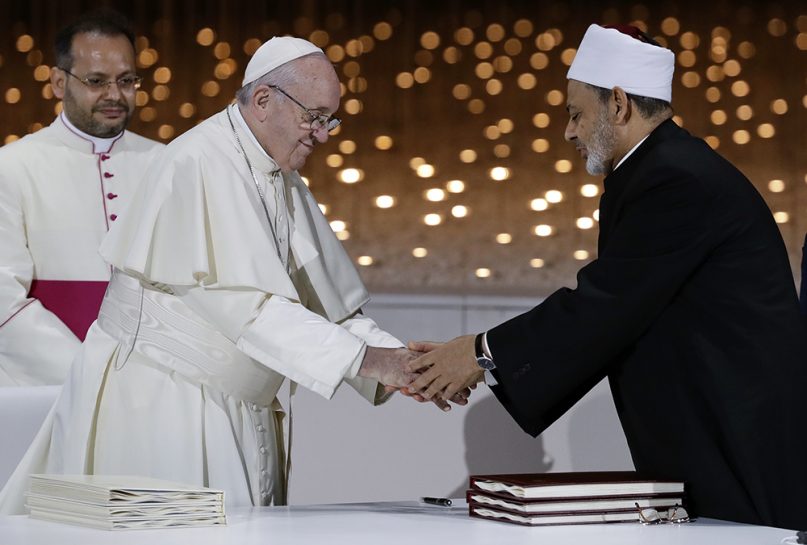
Pope Francis greets Sheikh Ahmed el-Tayeb, the grand imam of Egypt’s Al-Azhar, after an interreligious meeting at the Founder’s Memorial in Abu Dhabi, United Arab Emirates, on Feb. 4, 2019. (AP Photo/Andrew Medichini)
Francis left a powerful mark in the way the Catholic Church interacts with other religions. He promoted interreligious dialogue by focusing on what global faiths shared, rather than their theological differences, and pursued interfaith charitable efforts for the poor and the environment. In 2016 he signed a joint declaration against Christian persecution in the Middle East with the Orthodox Patriarch Kirill of Moscow and in 2019 signed a historic document on Human Fraternity with Sunni Sheikh Ahmed el-Tayeb, grand imam of Al-Azhar.
In his multiple foreign trips, Francis favored “the global peripheries,” choosing to visit countries in the Global South and those distant from the Western power centers.
Diplomatically, he juggled difficult relationships with Russia, China and the United States. He will be remembered as a pope who withdrew from the Atlantic alliance favored by his predecessor John Paul II while attempting to mediate a bridge with Beijing and the Kremlin. Under his papacy, the Vatican signed and renewed a controversial deal with China that gave Beijing a voice in the appointment of bishops, which critics say limited the pope in condemning human rights violations by the People’s Republic.
RELATED: Pope Francis: An appreciation
Francis also strived to make the Vatican a mediator for peace in what he described as a “Third World War fought piecemeal” in Syria in 2013, Ukraine in 2022 and the 2023 war in the Holy Land. He also advocated for peace in South Sudan, Yemen and Myanmar.
Francis diligently kept to the Vatican’s tradition of remaining above the fray, even avoiding calling Russia the aggressor in Ukraine and holding numerous meetings with both parties in that conflict. The pope condemned terrorist attacks against Israel while pleading for the lives of Palestinians in the Gaza Strip.
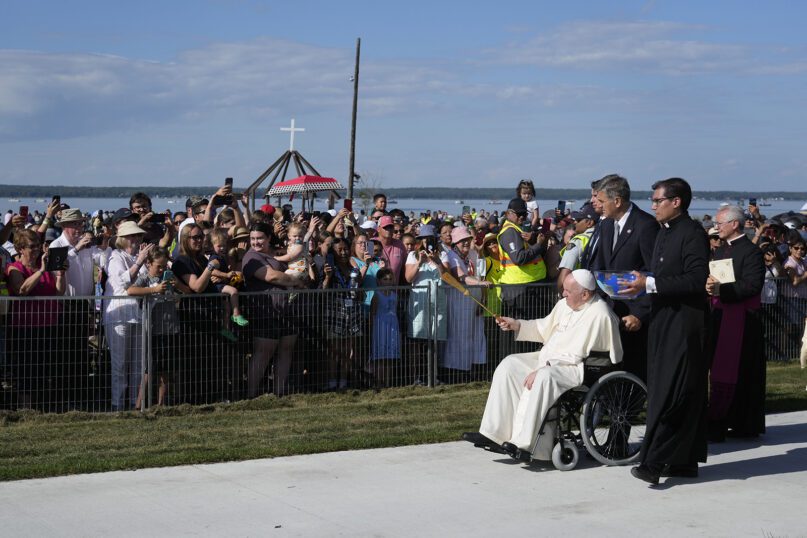
Pope Francis blesses the faithful as he arrives at the Lac Ste. Anne pilgrimage site in Alberta, Canada, July 26, 2022.
“Pope Francis served the world, not just the Catholic Church,” said journalist Victor Gaetan, author of the book “God’s Diplomats: Pope Francis, Vatican Diplomacy, and America’s Armageddon.” “From the first months of his papacy, he worked quietly, and diligently, to promote peace. His engagement often made a difference, as in Syria in 2013 or Colombia in 2016. Other times, geopolitics undermined his diplomacy of dialogue and encounter.”
Francis successfully prioritized relations with the Arab world, Gaetan explained, leading to the first-time-ever invitations to visit the United Arab Emirates (2019) and Bahrain (2022), then to mutual recognition between Oman and the Holy See (2023).
“Pope Francis showed us that Christ-like diplomacy can be real, not just aspirational, and this differs from how global powers are running the world,” he said.
The pope’s refusal to take sides in a time of war, to double down on doctrine amid mounting secularism and to provide quick solutions in a fast-paced world contributed to making Francis a highly divisive figure in the history of the church. His opponents called him authoritarian and a heretic, some even asking that he step down as pope.
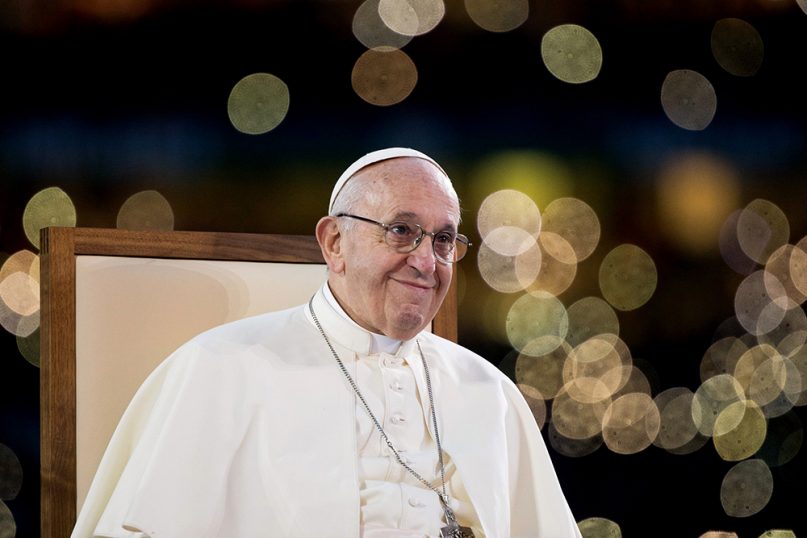
Pope Francis smiles during services at Croke Park, Dublin, on Aug. 25, 2018, during the World Meeting of Families 2018. (Photo by Maxwell Photography/WMOF2018)
His supporters praised him for fostering a climate of dialogue and frankness that allowed forms of criticism to be fearlessly expressed in the first place.
“He is a pope who opened the doors,” Borghesi said. “In little time, the pope was able to restore credibility to the church in the world. This pope cleared the air, allowing Catholics to meet the world of today with their head held high and with the desire to communicate the beauty of the Christian truth to the world.”
Francis leaves behind him a church still divided, but radically transformed. Cardinals meeting at the conclave to elect the next pope will have the task of deciding what identity the church should pursue from now on, knowing that the expectations of 1.3 billion Catholics and the world are forever changed.
